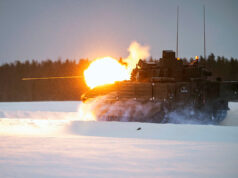The British Army have taken delivery of the first new cutting-edge bomb disposal robots, say the MoD.
The delivery of the first four is part of a contract of £55 million for 56 robots. According to the Ministry of Defence:
“The Harris Corporation’s T7 unmanned ground vehicle (UGV) are equipped with high-definition cameras, lightning-fast datalinks, an adjustable manipulation arm, and tough all-terrain treads, allowing them to neutralise a wide range of explosive threats.
The game-changing platform endured a variety of tests during an eight-week ‘acceptance’ trials period at UK and US sites specifically chosen to put the robots through their paces.”
Defence Secretary Gavin Williamson said:
“These robots will go on to be an essential piece of kit, preventing harm to innocent civilians and the brave operators who make explosives safe.
The robots will provide the Army with the latest bomb-disposal technology and will prove to be trusted companions both on UK streets and in deadly conflict zones.”
Col Zac Scott, Head of the Defence EOD & Search Branch said:
“Remote Control Vehicles (RCVs) are critical to the safe conduct of Explosive Ordnance Disposal (EOD) tasks.
The Harris T7 harnesses cutting-edge technology to provide EOD operators with unprecedented levels of mobility and dexterity. It represents a step-change in capability for our service personnel and it will save lives.”
The bomb disposal robots have been procured by Defence Equipment and Support, the MOD’s procurement organisation, under Project Starter. The deal was announced in September 2017 at the Defence and Security Equipment International Exhibition in London.













The British army might be allot smaller than before but once all the equipment from the 176 billion being spent on the UK millitary over the next decade is done it will surely be one of the best equipped army’s on earth. It will be one of the most capable on earth also.
India and china might have huge numbers but that’s mostly only for defence of the nation in the nation like a previous UKDJ post stated, where Britain is far better is expeditionary operations, I would love to see how India and china do at expeditionary operations with say 50,000 personnel for a few years over the other side of the globe. Is it 40,000 or 50,000 that Britain can deploy if needed as an expeditionary force? Obviously reserves will be there, but they are far better equipped and trained than say the old TA these days and they are properly integrated into the millitary now also which must make for a better bigger force.
My understanding is that ‘Army 2020 Refine’ post SDSR 2015, is to allow very high readiness of a single Strike Brigade (2 in total) constituting 5,000 personnel made up of Heavy Armour, Mechanised, Infantry, Arty & RLC etc… including 3 sabre squadrons of Chally 2 and Ajax each (54 of each vehicles)… whether the second Strike Brigade is to be as easily deployable I do not know. Even if that is the case that’s only 10,000 soldiers… the idea of deploying 50,000 soldiers indefinitely sounds massively optimistic.
In an all out shooting War with a near peer advisory I presume the 10,000 figure would be built on but god knows actual numbers. I assume that’s down to the planners and top brass.
Never liked the idea of the Strike Brigades, they always seemed too inflexible but hey! Each to their own.
50,000 personnel in total across all services based on the 2015 SDR and what was reiterated in the MDP just released and quoted below, certainly not 50,000 soldiers though;
“The 2015 SDSR put UK Defence firmly on the right path. It established our vision for Joint Force 2025, to equip us with a range of new and enhanced capabilities that offer us choice, agility and global reach. It established a central ‘planning assumption’ for Defence, that if called upon by Government the Armed Forces should be able to deploy a highly capable expeditionary force of around 50,000, including:
1. A maritime task group centred on a Queen Elizabeth Class aircraft carrier with F35
Lightning aircraft
2. A land division with three brigades including a new Strike Force
3. An air group of combat, transport and surveillance aircraft
4. A Special Forces task group.
This planning assumption remains unchanged, and we have made good progress in turning it into reality.”
I assume the land division (3 Brigades) will be Strike, Logistic/Support & HQ/REMFs? Not said REMFs in a while!! 🙂 All in good humour…
Maybe 15,000 Army soldiers then… not bad at all really plus a Special Forces contingent and Royal Marines – a significant increase on the deployed troops from Herrick then, which were circa 10,000 I believe at their height?
Top Brass wishes and reality aren’t always aligned though… very interested just how close to achievable this scenario actually is! Come 2025 at least.
Where did 2025 come from, wasn’t it 2020 before. It’s easy to be on track, if you keep quietly moving the deadline
It’s 40/50,000 total British expeditionary force with all branches included I was on about m8.?
Cam, The British Army Is certainly A lot smaller, actually, It’s the smallest It’s been since 1780. Certainly better equipped though.
The problem as always is holding and maintaining control of an area. This was proven time and again if Afghan, where an operation was launched to engage the Taliban or Al Qaeda. Where they’d initially stand around for a fight then just melt away, after the drugs wore off. Once the operation was finished we’d bug out back to the FOBs and they’d drift back filling the void.
The problem was a lack of active fighters to maintain control over the area to continue exerting pressure and pushing 24/7. This can only be done with numbers. Technology has constantly been promoted as the answer, but always fails when seriously stressed or used outside its design parameters.
In a peer vs peer war the key will be constant mobility and the ability to strike unexpectedly. We simply cannot do that with just 1 or 2 strike brigades. They won’t be able to sustain losses or maintain momentum.
So what’s the answer. Perhaps we should reinvent what the Romans did, i.e. if you want to be a citizen of this country you have to pay for it with X years of service. Realistically they should be split between one deployable heavy and one deployable light. But have three rotational brigades each, i.e. one deployed on operation, one on work up and one on standown/recovery. But seriously the three services of the armed forces are too small to engage in any lengthy conflict where the natives are armed with more than “sharpened mangos”!
Sounds like the voice of experience, much appreciated. Whats the saying? “Quantity has a quality of its own”. However sophisticated the kit, it can only be in one place at a time, and imo what is lacking across all services is critical mass. I’m waiting for the Russkis to try overstressing the RAF’s QRA setup by multiple approaches of Blackjacks in different locations.
Rfn.
I believe there will be one Armoured and one Strike Brigade at readiness, not just one Strike Bde.
With another of either type added later to form a deployable division, aided by assets from Force Troops.
Trevor.
I’d be delighted if they did as something needs to force the grown ups upstairs to act.
I don’t think the Russians have that sort of capability though regarding Blackjack.
It’s not just the mass that is the problem it’s the quality of the kit that will trip us up. We have some very well trained people but you can only work with the tools provided, and quite frankly those tools are falling apart. If only I could say more but if you dig deep down into our capabilities you will see most of it is a facade, a thin veneer of capability to keep Joe public from noticing the rot.
BV